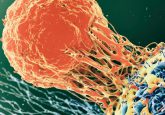Ovarian cancer: SOX2 & SIK2 may represent novel diagnostic marker/therapeutic target
In twin papers published recently in the journals Cancer Cell and EBioMedicine, a group of researchers at Oxford University (UK) have highlighted the potential role of SOX2 as a diagnostic biomarker and SIK2 as a possible target for future treatments for ovarian cancer.
First, in the study outlined in EBioMedicine, the team demonstrated that the protein SOX2 is highly expressed in the fallopian tube epithelial cells of women with high-grade serous ovarian cancer, as well as in women with BRCA1 and BRCA2 mutations.
Lead author of both papers, Ahmed Ahmed (University of Oxford) commented: “Ovarian cancer can be undetectable for up to 4 years and only a third of people with the cancer get an early diagnosis. A test for SOX2 could not only help detect cancers early but in some cases would enable us to detect a tumor before it becomes cancerous. Early treatment hugely improves the odds for patients, so early detection is essential.”
Currently used screening techniques for ovarian cancer can only detect the disease once it is in its advanced stages. Researchers hope that by harnessing the fact that high levels of SOX2 are found in ovarian cancer, they can develop biomarker tests to detect the disease at a premalignant stage.
Considering that ovarian cancer responds well to chemotherapy in its early stages but becomes resistant to chemotherapy once established, a biomarker to diagnose the disease at earlier stages could have substantial impact.
In their second paper, published in Cancer Cell, the team demonstrated that high levels of the enzyme SIK2 are required for malignant growth in the adipocyte-rich microenvironment that forms a niche for ovarian cancer metastasis (the omentum), making it a potential target for ovarian cancer drug development.
Ahmed explained further: “…we have found that ovarian cancer could only proliferate – grow – in the presence of an enzyme called SIK2… SIK2 is an important target for future treatments because it provides cancer cells with energy and also drives their increase in number. Our experiments showed that suppressing SIK2 disrupted these pathways, which in the human body would reduce the possibility of cancer cells spreading and ‘coming back’.”
Although these experiments are in their early stages, the researchers hope to exploit their findings in order to propose new diagnostic techniques and therapeutic strategies for ovarian cancer.
Sources: Hellner K, Miranda F, Chedom DF et al. Premalignant SOX2 overexpression in the fallopian tubes of ovarian cancer patients: Discovery and validation studies. EBioMedicine. DOI: http://dx.doi.org/10.1016/j.ebiom.2016.06.048 (2016); Miranda F, Mannion D, Liu S et al. Salt-Inducible Kinase 2 Couples Ovarian Cancer Cell Metabolism with Survival at the Adipocyte-Rich Metastatic Niche. Cancer Cell. DOI: 10.1016/j.ccell.2016.06.020. (2016) [Epub ahead of print]; University of Oxford press release




